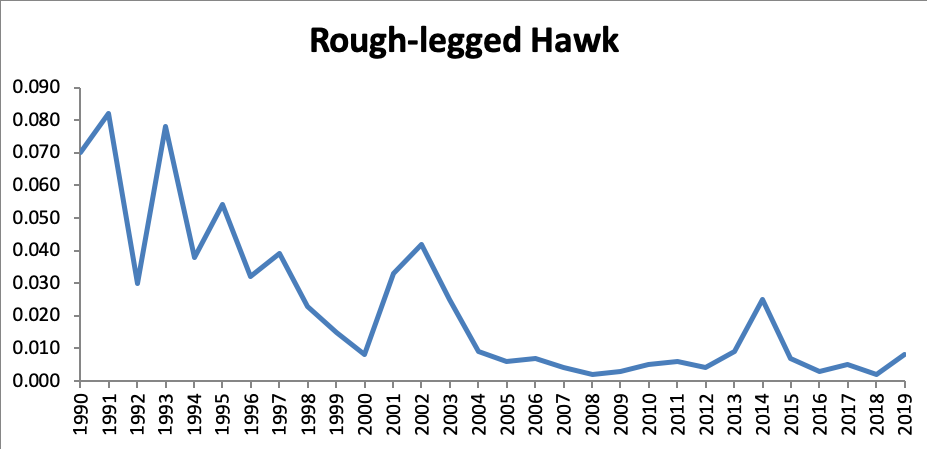Fluctuating Numbers of Wintering Raptors Reflect a Cold Northern Winter and a Locally Fractured Environment
Since 1983, volunteers with the Boulder County Nature Association have monitored winter raptors. Volunteers driving six survey routes throughout the plains of Boulder County detected more wintering raptors during 2018-19 than had been seen during any previous fall-winter season (15 October-15 March) of the 30-year study. These high numbers were driven by a near-doubling of the number of detected Red-tailed Hawks from 2017-18 to 2018-19 (Figure 1).
Red-tailed Hawks are human-adapted generalists who thrive in suburban environments. Their numbers on the Boulder County Nature Association raptor survey routes have increased from an average of 0.18 individuals/km during 1990-95 to 0.37 individuals/km during 2014-19. Meanwhile, numbers of Ferruginous Hawks, open country grassland specialists, have plummeted (Figure 1). While there was a slight uptick in numbers of observed Ferruginous Hawks during 2018-19, mean numbers observed declined by more than 90% from 1990-94 to 2014-19.
Figure 1. Mean number of Ferruginous and Red-tailed Hawks observed per kilometer along six Boulder County wintering raptor survey routes, 1990-2019
The slight increase in observed numbers of Ferruginous Hawks during 2018-19 probably stemmed from frigid late fall and winter conditions over the northern Great Plains, along with an increase in prairie dog numbers in northern Boulder County. However, fragmentation or elimination of large prairie dog colonies in southern Boulder County, along with local extirpation of white-tailed jackrabbit, another preferred prey species, seem to have deterred these large buteos from congregating here as they did during the 1980s and early 1990s.
Cold conditions in the northern plains may also have contributed to the slight increase in numbers of observed Rough-legged Hawks during 2018-19 (Figure 2). These tundra-nesting buteos prey on small mammals and typically migrate south only as far as necessary to avoid persistent snow cover. The winter "snow line" has been racing northward as North America has warmed, and wintering Rough-legged Hawks have become uncommon in Boulder County. I suspect that fragmentation of remaining grasslands throughout eastern Boulder County has also contributed to this decline.
Figure 2. Mean numbers of Rough-legged Hawks observed per kilometer along six Boulder County wintering raptor survey routes, 1990-2019.
Numbers of wintering Bald Eagles increased sharply during 2018-19 (Figure 3), primarily due to groups of adults and juveniles congregating around expanding prairie dog colonies near Lagerman Reservoir and the Potato Hill area south of St. Vrain Road. During January and February surveys, volunteers observed as many as 10 Bald Eagles perching around Lagerman Reservoir.
Figure 3. Mean numbers of Bald Eagles observed along 6 Boulder County wintering raptor survey routes, 1990-2019.
Numbers of wintering Golden Eagles also increased, probably in response to the short-term increase in prairie dog numbers in northern Boulder County, but wintering populations still remain low compared to historic levels. While most known Golden Eagle nest sites in Boulder County remain active, our grasslands seem to be growing too fragmented and our active prairie dog colonies too small to attract the concentrations of hunting eagles that we observed during the 1980s and 1990s.
Figure 4. Mean numbers of Golden Eagles observed per kilometer along six Boulder County wintering raptor survey routes, 1990-2019.
While 2018-19 was a good winter for observing raptors, 36-year trends reflect eastern Boulder County's transition from a mostly rural environment with expanses of grasslands to a predominantly urban environment containing tree-filled fragments of protected open space. It's this transition that has no doubt caused local extirpation of white-tailed jackrabbits and near-extirpation of nesting Lark Buntings, both considered abundant Boulder County resident species 100 years ago.
It's unlikely that this trend will reverse itself so long as our human population continues to grow and our remaining grassland fragments continue to be invaded by non-native trees, shrubs, and forbs. Saving native grassland species in Boulder County is going to take a much stronger commitment and vision, starting with acknowledging that native ecosystems and their native species populations have the right to exist and thrive here.
Without this overarching vision, local governments and agencies will continue to manage our remaining grasslands through compromise with developers, recreation advocates, and various government departments (such as transportation, planning, and utilities) which have minimal interest in preserving native species.
Observers reporting in 2018-19: John Adams, Linda Andes-Georges, Grace Apodaca, Jane Argullo, Kari Armstrong, Beth Baker, Dale and Jamie Ball, Ramesh and Suzanne Bhatt, Barbara Brandt, Kerrie Bryan, Cindy Buchenroth-Martin, Jack and Ryan Bushong, Sue Cass, Jasey Chanders, George Coffee, Sue Coffee, Bev Cole, Cathy Cook, Pat Cullen, Jean and Michael Delaney, Holly DeVaul, George and Sandra Durazzo, Robin Ecklund, Fern Ford, Linda Gathany, Dan and Eva Getman, Dara Glazer, Scott Hathcock, Paul and Robin Heglund, Brinda Henley, Carol and Jim Holitza, Amy Iwata, Brad and Janet Johnston, Steve Jones, Kristin Laubach, Sandra Laursen, Viki Lawrence, Cindy Luong, Carol McCasland, Anyill Markevitch, Andy Martin, Jo Masternach, Eliza, Holden, and Mary Maxfield, Merle and Sally Miller, Zach Pesch, Mark and Sue Ponsor, Bev Postmus, Ira and Tammy Saunders, Carol Sazama, Mary Sue and Paul and Schultz, Leonard Sitongia, Reid Sprague, Carl Starace, Terry Stuart, Mary Stuber, Darin Toohey, Annelise and Regnar Trampedach, Claudia VanWie, Mark Venzke, Lysa and Mort Wegman-French, Tim Weston, Curt and Maribel Williams, Howard and Pattiann Witkin, Noonie Yaron, George Young.



